Garlic, Allium sativum
▶ Watch: Growing Garlic in Wisconsin
Growing Onions, Garlic, Leeks, and Other Alliums
Authors: Susan Mahr, University of Wisconsin-Madison, Lauren Mortenson, Horticulture Outreach Specialist
Rev: 10/2023
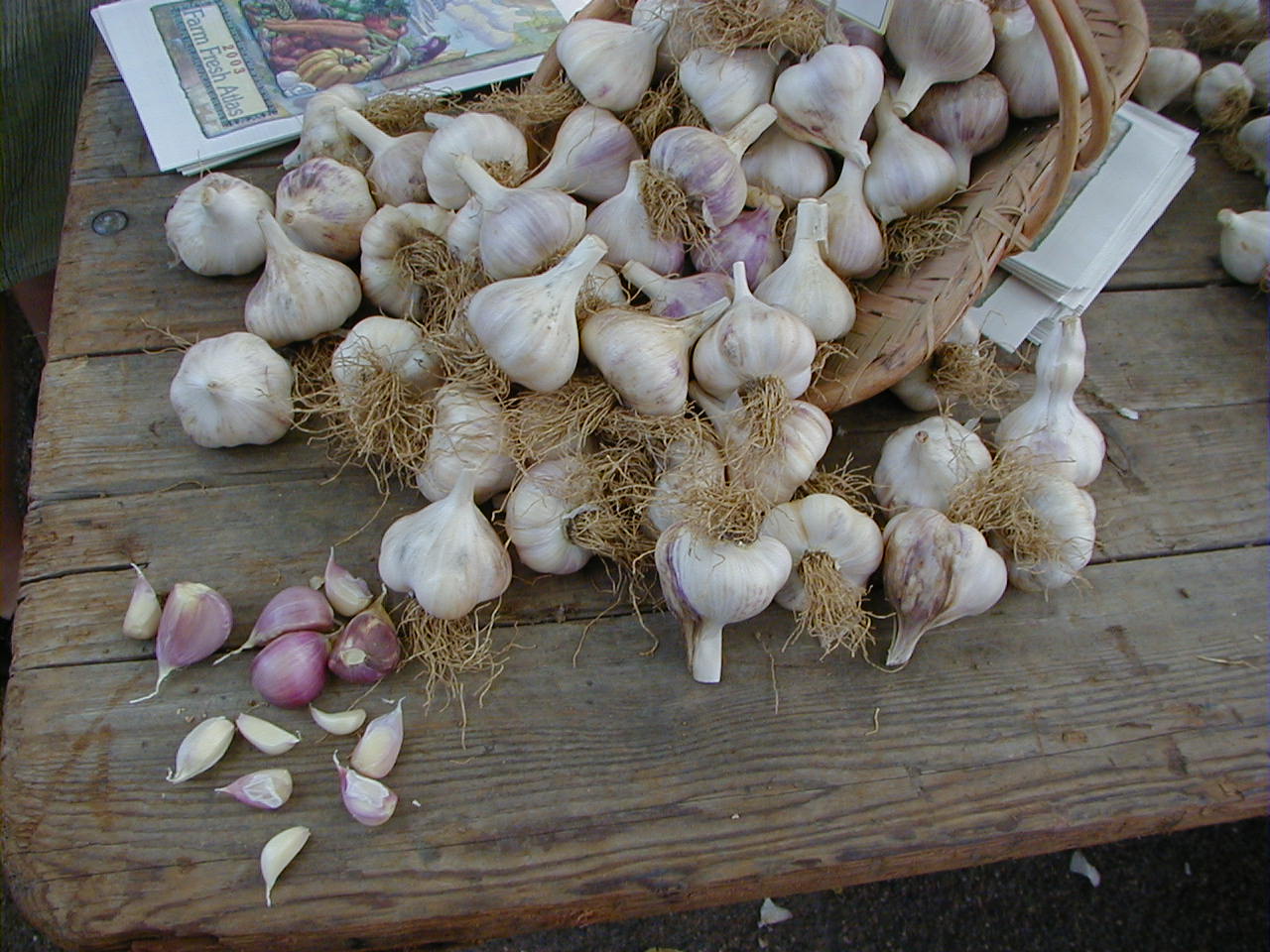
Introduction
Garlic (Allium sativum) is one of the best known herbs around the world. This perennial plant, most often grown as an annual, produces edible bulbs composed of a number of cloves. It is generally agreed that garlic evolved from the wild garlic A. longicuspis. The exact origin of garlic is unclear; it grew wild in a large area from Siberia to India to Egypt to Central Europe and spread through southern Europe. It is still cultivated in most Mediterranean countries today.
Origin
Garlic probably developed in south-central Asia, in the “garlic crescent” that ran from the Black Sea east through the southern Caucasus Mountains of Georgia, Armenia, and Azerbaijan, beyond the Caspian Sea in the Kopet Dagh Mountains of northern Persia (Iran) into southern portions of Uzbekistak and Turkmenistan, to the Hindu Kush Mountains though northern Afghanistan and on through Tajikistan and Kyrgyzstan, the Pamir Mountains and the Tien Shan Mountains of China. The rugged foothills of these various mountain ranges of the Himalayas are probably the true birthplace of garlic, although it was known in all early civilized cultures, including the Babylonians, Egyptians, Romans and Chinese.
Wild garlic came from areas with a harsh continental climate of hot, dry summers with intense sunlight and long cold winters. It would mature in late spring, then stay dormant until the cooler, moister fall and then begin another cycle of root growth. In early spring, shoots would spring up rapidly and plants would form bulbs and complete their growth before the soil dried out and the scorching sun arrived.
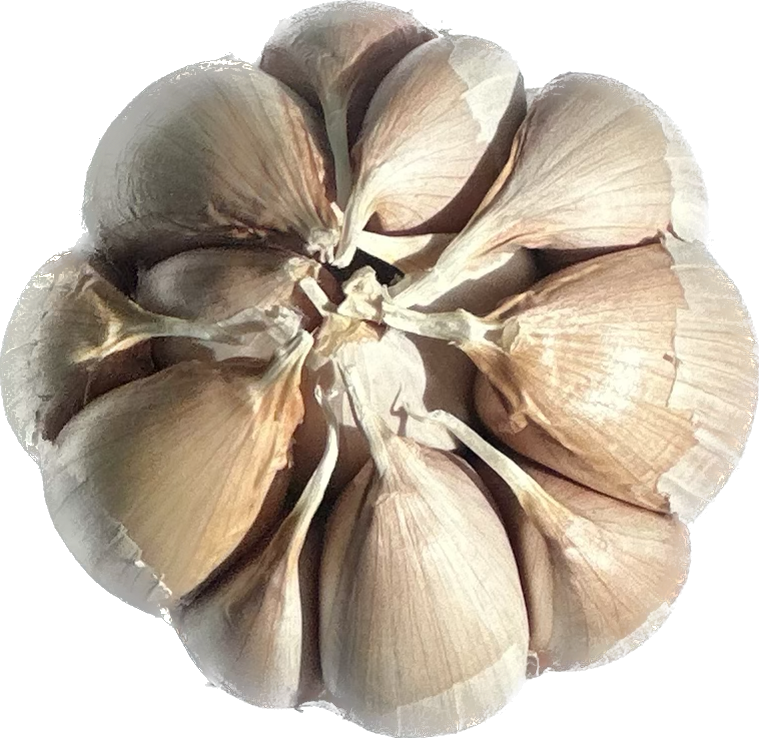
When it was moved to the Mediterranean and continental Europe, garlic had to adapt to year-round rain, cooler summers and/or milder, wetter winters. This exposure to a variety of climatic conditions probably led to the diversification of varieties we have today.
Regardless of garlic’s exact place of origin, this member of the onion family has been cultivated for thousands of years for both culinary and medicinal uses. Garlic’s volatile oil contains many sulfur-containing compounds – although not as much of the sulfuric acid that makes your eyes water as onions have – that are responsible for the strong odor, as well as for its healthful benefits.
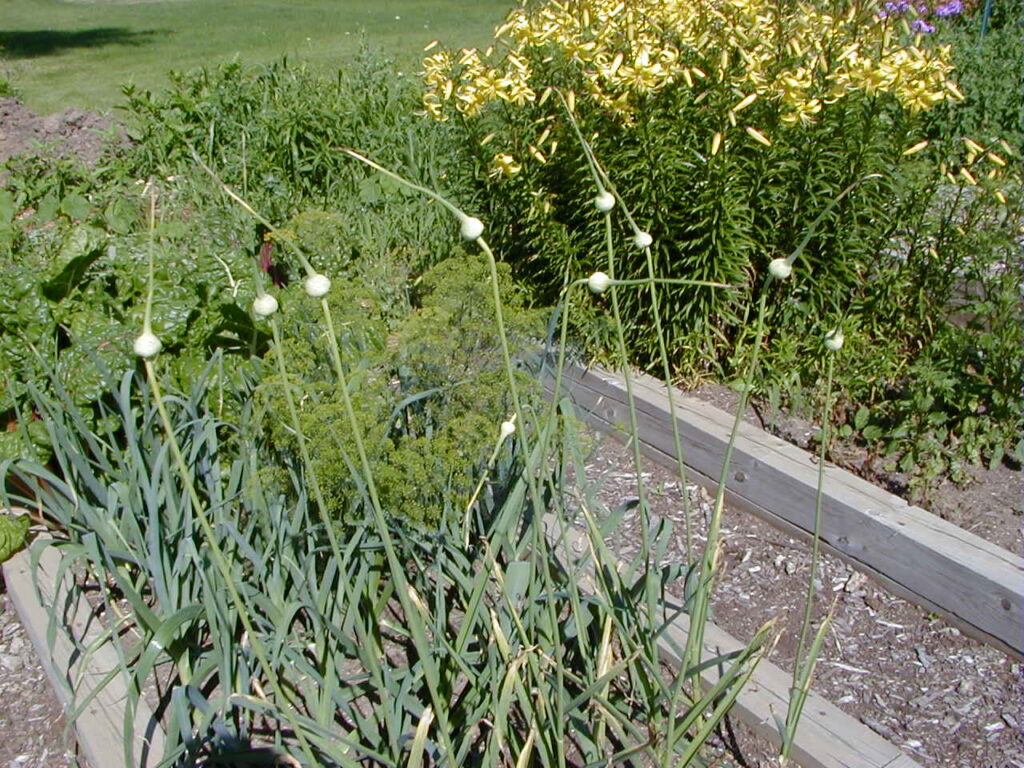
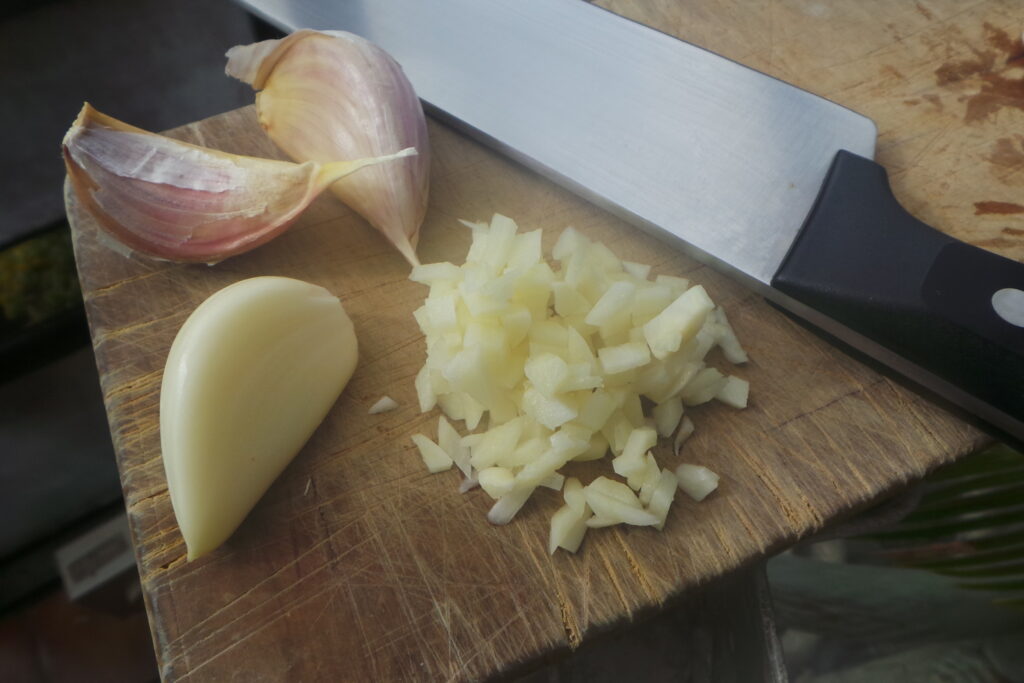

Garlic taxonomy is a mess with even the experts confused about the true relationship of the hundreds of different varieties, partly because the characteristics of garlic varieties are influenced by the local environment. The common names given to many varieties are not really indicative of their true origins. For example, the name “Italian” has been applied to many varieties only because Italian immigrants brought them here, not because they originated there.
Hardneck vs. Softneck Garlic
Garlic is only propagated from the bulbs, since it has lost the ability to produce fertile seeds – some varieties don’t even produce flower stalks or flowers. The numerous varieties available today are presumably the result of random mutations. Garlic varieties can be broadly categorized as either hardneck (subspecies ophioscorodon) and softneck (subspecies sativum).
Hardneck Garlic
Hardneck types are quite similar to wild garlic. They all produce a woody flower stalk – called a scape – while softneck types do not. If flowers are produced they usually abort and form bulbils (small, aerial cloves) instead. Although these bulbils can be planted, the bulbs they form will be very small, requiring two or three years to reach usable size. Some types may not produce large bulbs unless the flower stalks are removed. Hardneck types typically have four to 12 cloves in a single circle surrounding the stiff stalk (which can’t be braided) and generally do not store well. These types perform best where winters are long and the season of vegetative growth is relatively short.
Within hardneck garlic, there are three further subdivisions:
Rocamboles
Rocamboles are the most commonly grown hardneck garlics, having exceptional flavor. There is some confusion with the term ‘Rocambole’ because it has also been applied to another Allium species, A. scorodoprasum. Rocambole garlics have dark green or blue green leaves, a moderate spreading shape and a tightly coiled flower stalk with one to three loops. The bulbs are off-white with various amounts of purple blush or streaking and 6-11 plump, dull colored, easy-to-peel cloves. Because they begin root growth in the early fall, they generally have a limited season of 3 to 4 months before quality deteriorates in storage.
Porcelain
Porcelain garlics are not very common in North America. They are taller than Rocamboles, with pale to deep green leaves and looping or irregularly coiled scapes. The bulbs are a satiny white with only 4-6 large cloves that are more difficult to peel than the Rocamboles (but easier than softnecks). These types store longer than Rocamboles, for 4 to 8 months. Their flavor is often mild at harvest but intensifies during storage.
Purple Stripe
Purple Stripe or purple streaked garlics have bright purple streaks and blotches on both bulb wrappers and clove skins. They are also very flavorful, with most having 8-12 cloves. These types store slightly longer than Rocamboles and peel just as easily. The leaves on the plant grow at wider angles to the stem than Rocambole types do and the scapes often make perfect 270 degree curls.
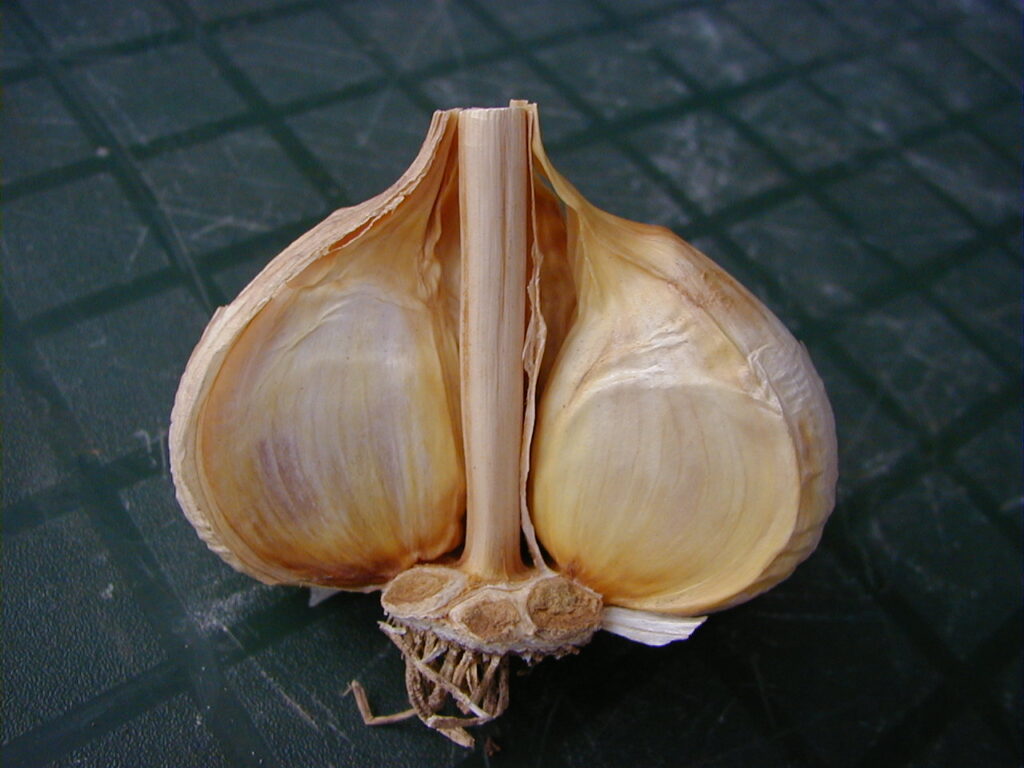
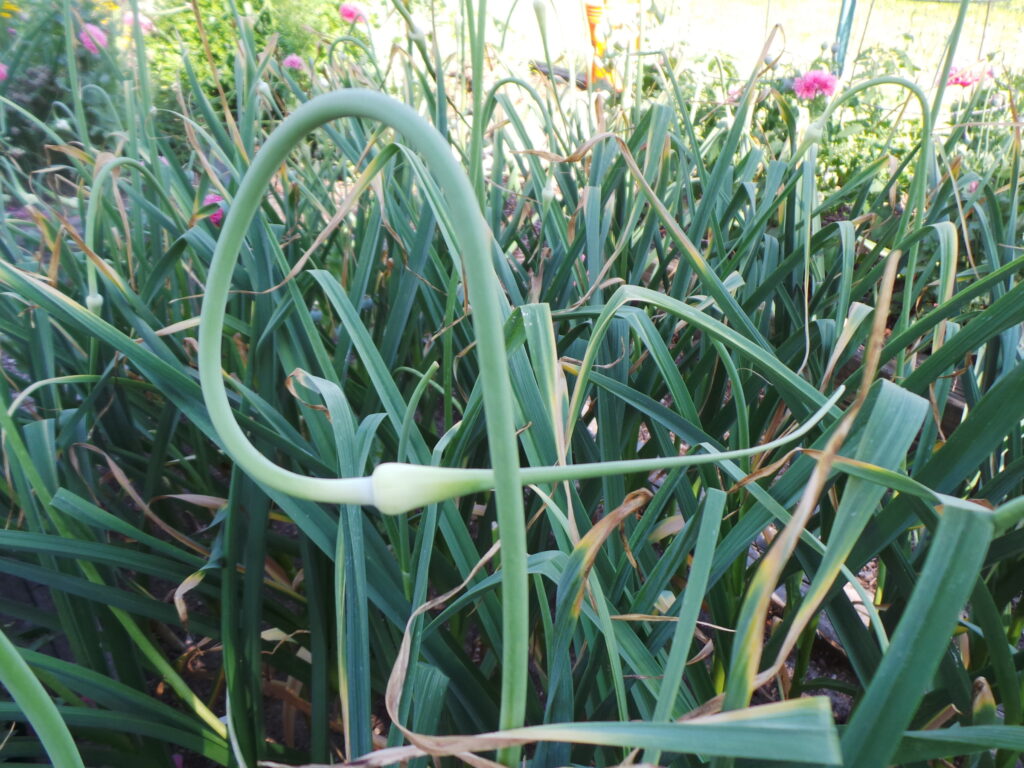
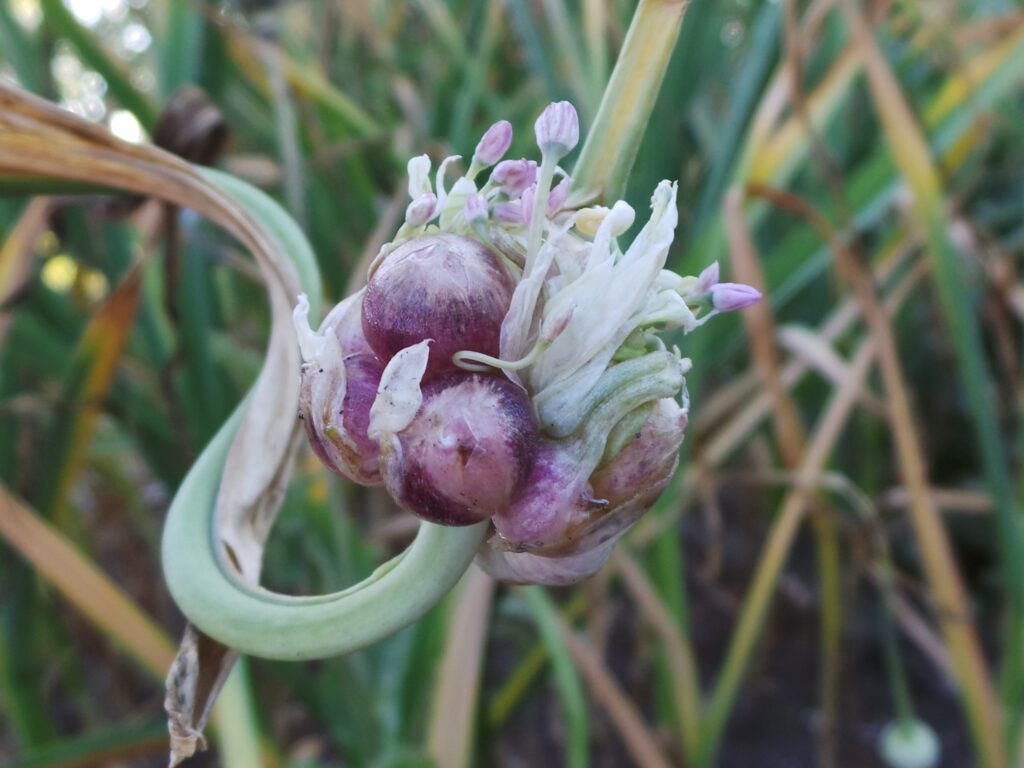
Softneck Garlic
Softneck types generally don’t form a scape and therefore the soft necks can be braided. They typically produce 10-40 cloves and often can be stored for 6-9 months. These large-bulbed, coarse-skinned garlics are highly productive in a wide range of climates and soils. Most have three to five layers of cloves. They tend to lack the flavor of hardneck garlic, having either a very hot or very mild taste. In general, a cold winter climate makes the taste hotter. These types are better adapted to areas with long seasons and mild winters. They can further be categorized in two groups:
Artichoke
Artichoke garlics are fairly upright plants with average to slightly pale green leaves, rarely with a flower stalk (occurs occasionally in some climates or on some individual plants). The bulbs are white and the cloves are generally milky white, with some having a pink or brown blush or partial striping. The skins adhere tightly, making them difficult to peel. There are two layers of cloves, with the inner ones tall, thin and narrow and plump, squarish outer ones. The flavor is variable from mild to hot, depending on strain and climate. These are the most adaptable garlics and the types grown commercially in California.
Silverskin
Silverskin garlics often have pale green leaves, rarely make a flower stalk, and produce white or pink blushed bulbs with either 8-12 or 18-24 cloves, depending on type. They perform best in mild winter climates and vary in flavor from very mild to very hot.
Elephant Garlic
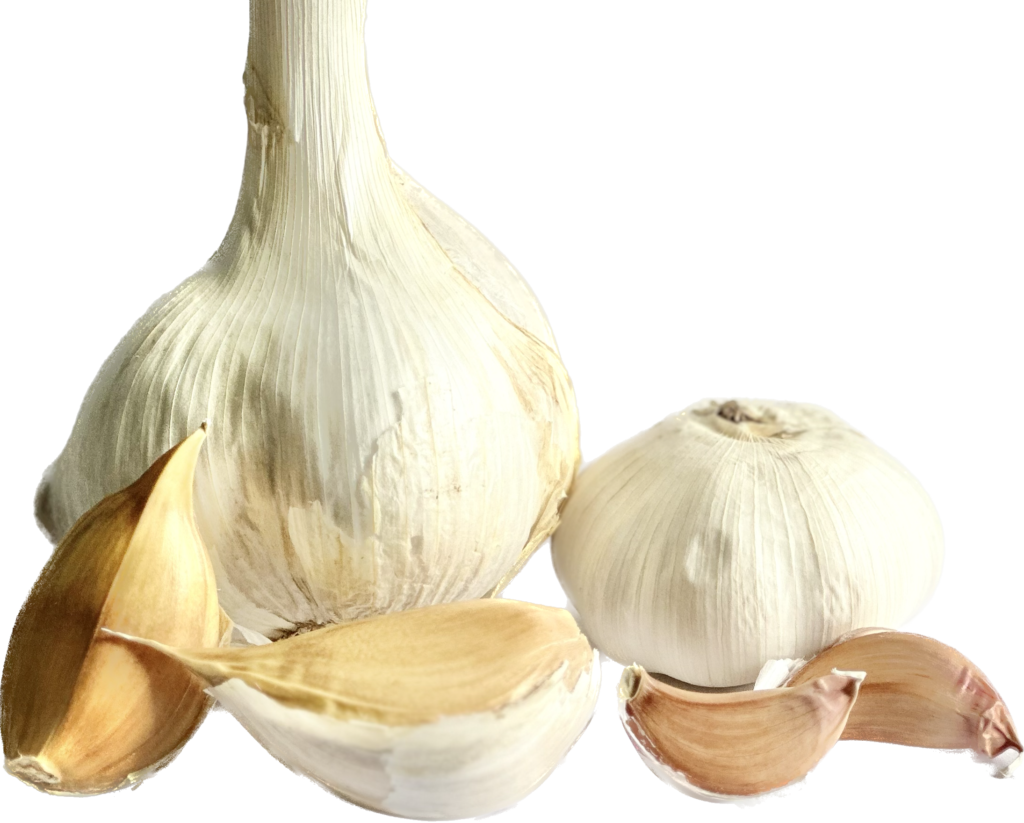
Elephant garlic (Allium ampeloprasum; left) is not a true garlic (right) – it is actually a type of leek. The extremely large bulbs with 5-6 cloves can weigh as much as a pound. The flavor is much milder than true garlic but a sharp or bitter taste sometimes develops in cold climates.
Garlic Varieties
Most commercially-produced garlic is grown in mild areas of California, centered around Gilroy (“The Garlic Capitol of the World”) in southern Santa Clara County and in the San Joaquin Valley. The varieties grown there, such as ‘California Early’ and ‘California Late’, do not adapt well to our colder climate and if they grow at all, they usually develop a very hot flavor. Planting cloves from garlic purchased at the grocery store is not recommended.
Over the years many other varieties that are much better suited to cultivation in cold climates have been selected and they often have better garlic flavor than the types grown in mild climates. However, varietal characteristics (from flower stalk formation to taste) can vary from location to location, and renaming cultivars grown in different areas is not uncommon, so selecting appropriate varieties can be difficult.
Hardneck garlic = Rocamboles (R); Porcelain (P); Purple Stripe (PS)
Softneck garlic = Artichoke (A); Silverskin (S)
| Variety | Description |
|---|---|
| ‘Brown Tempest’ | (PS) – brown cloves with a hint of rose blush and no stripes. The purple splotched bulbs average 6 cloves. It has a fiery flavor when eaten raw but that mellows to a pleasing aftertaste. It stores longer than many hardnecks |
| ‘Chesnock Red’ | (PS) – a good performer that holds its shape and retains flavor after it is cooked. Purple-striped wrappers hold 8-12 cloves. Hot, zippy flavor mellows in storage |
| ‘Georgian Crystal’ | (P) – large clean white bulbs with 4-7 cloves and mild but robust flavor. It has a mild flavor even when eaten raw so is good in dishes such as pesto, salsa, etc. |
| ‘German Extra Hardy’ | (P) – from Central Europe, with 4-7 big, full-bodied, spicy white cloves. Best used raw, as most of the flavor is lost in cooking |
| ‘Giant Siberian’ | (PS) – large white bulbs with 5-7 purple-striped cloves |
| ‘Inchelium’ or ‘Inchellium Red’ | (A) – vigorous with mild taste, but the 10-20 cloves can be difficult to peel. It stores well, with the flavor becoming more pronounced over time |
| ‘Italian Late’ | (A) – tight, light colored wrappers surround fat outer cloves with rich garlic flavor. Stores 6-9 months. Can be planted in spring |
| ‘Killarney Red’ | (R) – is better adapted to wet conditions than most others. Produces 8-10 pink skinned, easy-to-peel cloves |
| ‘Korean Red’ | (PS) – produces 4-8 large purple cloves in purple-striped bulbs. The big cloves are easy to peel and have a very hot flavor. Stores for 6 months or more |
| ‘Music’ | (P) – large bulbs with pink skin similar to ‘German White’ and robust flavor |
| ‘Polish White’ | (P) – large cloves inside the purple-striped wrapper |
| ‘Russian Red’ | (R) – 8-11 reddish brown cloves with strong flavor. Very easy-to-peel cloves. Stores for 6 months |
| ‘Silver Rose’ | (S) – rose colored cloves are enclosed in smooth, bright white wrappers. Stores up to 8 months. Can be planted in spring |
| ‘Spanish Roja’ | (R) – large cloves peel easily and have more subtle flavor than many other Rocambole varieties and is quite good eaten raw. Bulbs with 6-11 cloves store 4-6 months |
Growing Garlic
Garlic does best in full sun in well-drained soil high in organic matter. Bulb expansion can be impeded in heavy clay soils, especially if they dry out. Supplemental moisture may be needed early in the season on light, sandy soils. Prepare the soil well before planting to provide a loose growing bed for bulb growth.
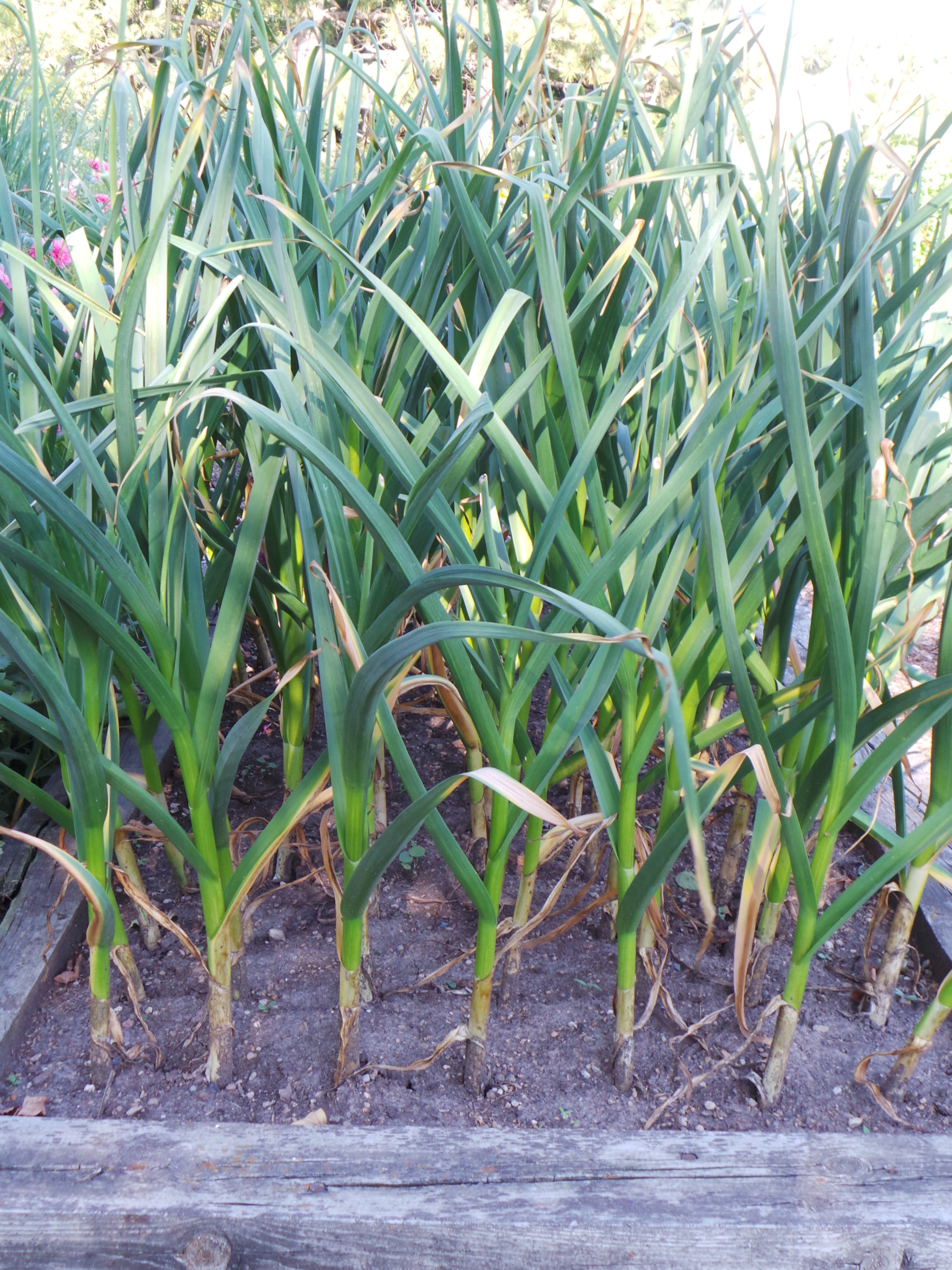
In Wisconsin, garlic should be planted in later summer or fall, usually within a week or two after the first killing frost. This will allow the roots to develop and shoots emerge from the clove but not grow above the soil by the first hard freeze. A period of cold is necessary for bulbing, so unless given a proper cold treatment prior to planting, most garlic varieties planted in the spring will produce weak shoots and poorly developed bulbs. Artichoke types do not seem to need winter cold as much, so these would be most suitable for spring planting. Spring planting should be done as early as possible to allow bulbs to form. Garlic left in the ground will start to develop new roots from each of the cloves during late summer.

The amount of garlic to purchase will depend on the area to be planted and variety (certain varieties have more plantable cloves per bulb than others). Generally, there are about 50 cloves per pound of cloves, although the average gardener isn’t going to be using that much. Single bulbs are offered for sale by many retailers. Also, locally-produced bulbs sold at Farmer’s Markets or obtained from small growers can also be used.
Separate the individual cloves from the bulb just before planting. Choose the largest cloves since they generally will produce the largest bulbs. The large cloves of some hardneck varieties are “doubles” (actually two cloves fused together) which will produce two bulbs that become flattened as they grow together. Place the cloves pointed side up, 2-3” deep and about 6” apart. Cloves planted too shallow are prone to injury during the winter and early spring. Mulching with 3-4” clean straw after planting will help minimize soil temperature fluctuations that can damage the developing roots and shoots. Remove the mulch in the spring after the threat of hard freezes has passed; it can be replaced after the shoots are about 6” tall to help control weeds for the remainder of the growing season.
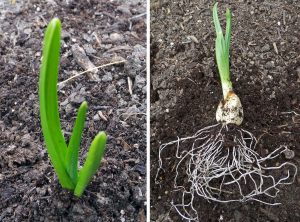
Garlic is a moderate to heavy feeder, so apply a nitrogen fertilizer at planting and again when the shoots are 4-6” tall. The leaf tips of many garlic varieties develop yellow tips even when soil fertility is adequate – often because of water stress – but unless it occurs early in the season before bulbing, this won’t affect yield. Garlic has a relatively shallow root system and is sensitive to moisture stress, especially during bulbing (about the end of May to mid July). Lack of water will result in smaller bulbs and earlier maturity. Provide supplemental irrigation if rainfall is not adequate. Stop watering when the foliage begins to wither to avoid stained bulbs and diseases.

Control weeds by shallow cultivation or mulching, as garlic is a poor competitor and bulb size will be reduced. Mulching will moderate soil conditions both during the growing season and during the winter. Any pesticide and weed seed-free material of moderate texture, such as fresh grass, chopped straw or pine needles, can be used. Avoid heavy mulches that may prevent the soil from warming up in the spring, may keep wet soils from drying out, or could prevent moisture penetration into the soil. Be cautious with wet leaves, fine sawdust or uncomposted manures that may actually form a barrier to the soil below.
The scapes of hardneck garlic can be removed just after curling starts, since yield can be reduced up to 30% when grown in poorly fertilized soil (but less than 5% reduction in well-fertilized soil). However, there is some circumstantial evidence that leaving the scape on until it turns woody may improve storage life.
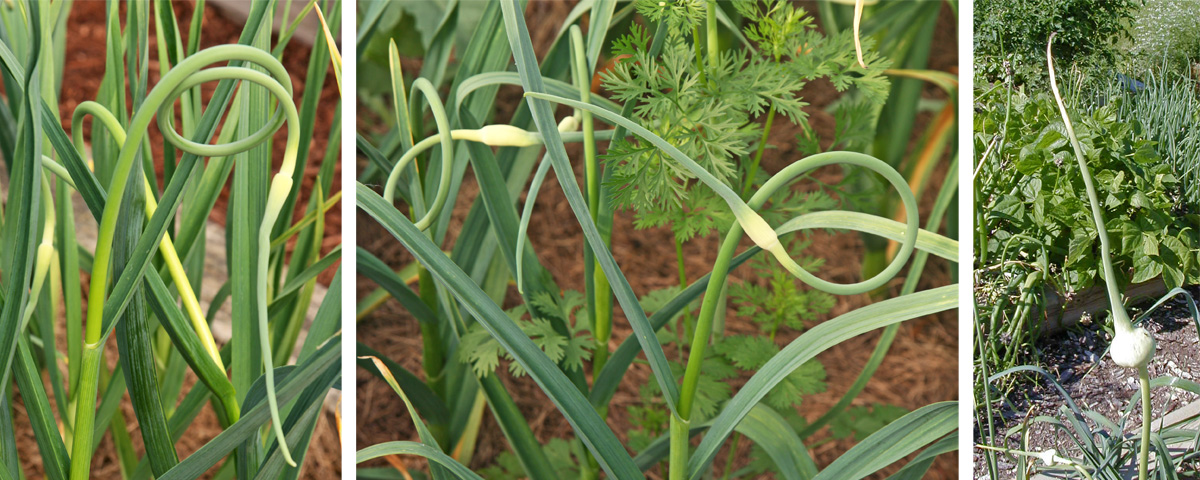
Garlic has few insect or disease problems in the home garden. Various fungi can cause decay in the ground and/or storage but using clean seed, planting at the proper spacing to allow good air circulation, and proper storage after harvest will reduce the potential for disease development.
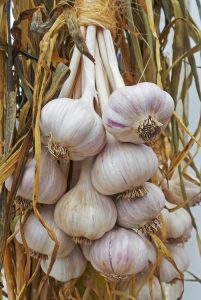
Knowing when to harvest is a little tricky, since different varieties mature at different times. Harvest too early and the small bulbs will not store well; harvest too late and the cloves may pop out of their skins, making them susceptible to disease. Harvest time is less critical for softneck varieties than hardneck varieties, as they are less likely to split open in the ground. Unlike onions, garlic doesn’t signal maturity by breakdown of the neck tissue. In general, garlic is ready to harvest when half of the leaves have turned brown. You can dig a couple of “test” plants to make sure their cloves fill the skins. The Artichoke types generally mature first, followed by the hardneck types, and finally the Silverskin garlics.
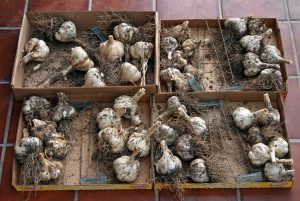
Dig the bulbs with the shoots still attached. Loosen the soil underneath the bulb and carefully pull up the entire plant by the shoot. Knock off the soil and allow to dry in a well-ventilated room. You can leave the tops intact or cut them down to a few inches above the bulb at this time. After curing for 3-4 weeks, the roots and remaining shoots should have dried down. Cut the tops to ½-1” above the main bulb and trim roots close to the base of the bulb. Clean the bulbs by removing the outermost skins and brushing away any remaining soil. It is best not to wash the bulbs, as the moisture could encourage disease. Garlic stores best as whole bulbs; cloves separated from the parent bulb deteriorate more rapidly than whole bulbs.
Store garlic bulbs in a cool place to prolong storage life. Generally, hardneck garlic can be stored for only 3-4 months at room temperature without significant deterioration in quality, while softneck garlic generally can be kept at room temperature for 6-8 months. Storing hardneck garlic at 32°F will extend storage life up to 7 months; higher temperatures will cause sprouting and higher humidity will promote rooting. If you intend to use the garlic for seed to replant in your garden, store at room temperature until planting.
Culinary Uses
Garlic is a practically ubiquitous culinary herb used in a wide variety of cuisines throughout the world, especially French, Italian, and Chinese. Garlic goes with just about any savory food and is a critical element in many sauces and dressings. It can be used to flavor butter, vinegar, or oil, and its distinctive flavor enhances meat, vegetables and other dishes. With a little imagination it can even be used in desserts! Garlic fudge may not be for everyone but any garlic-lover should try this once.

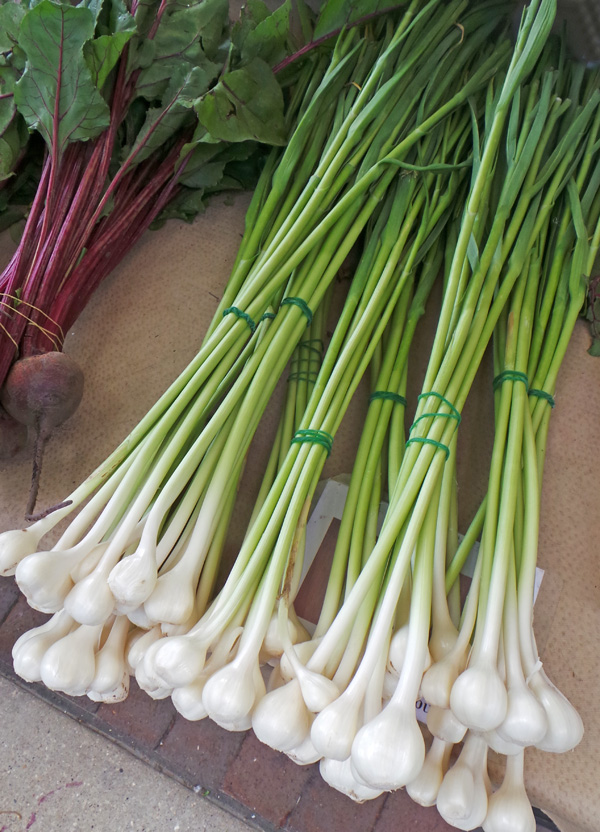
Mature bulbs and cloves are the most common form of garlic sold but green and young garlic is sometimes offered at farmer’s markets. Green garlic, harvested in the spring, has tender leaves that can be used just like green onions but with a mellow garlic flavor. Young garlic is harvested in early summer with immature bulbs and a stem that is usually too tough to eat. The flavor of these bulbs is generally milder than that of the mature bulb, so is especially good for using raw.
Immature garlic scapes can also be eaten raw or cooked, whole or chopped as a vegetable. They should be harvested when still curled and before the flower buds develop; when straight or the flowers are out, they are woody and inedible. They have a mild but unmistakable garlicky flavor and can be used the same way as garlic in any recipe.

▶ Watch: Growing Garlic in Wisconsin
Whether you are a garden enthusiast, a foodie, or both, garlic is well known around the world! In this webinar you will learn techniques for growing garlic from planting to storage.
Growing Onions, Garlic, Leeks, and Other Alliums
K.A. Delahaut, A.C. Newenhouse
Revised: 10/10/2011
Item number: A3785
This detailed publication offers plenty of tips on how to grow various alliums such as sweet onions, leeks, storage onions, scallions, and garlic. Includes information on site and cultivar selection, planting, soil and irrigation management, dealing with insects, diseases, and weeds, and tips for harvesting, handling, and storage (21 pages).

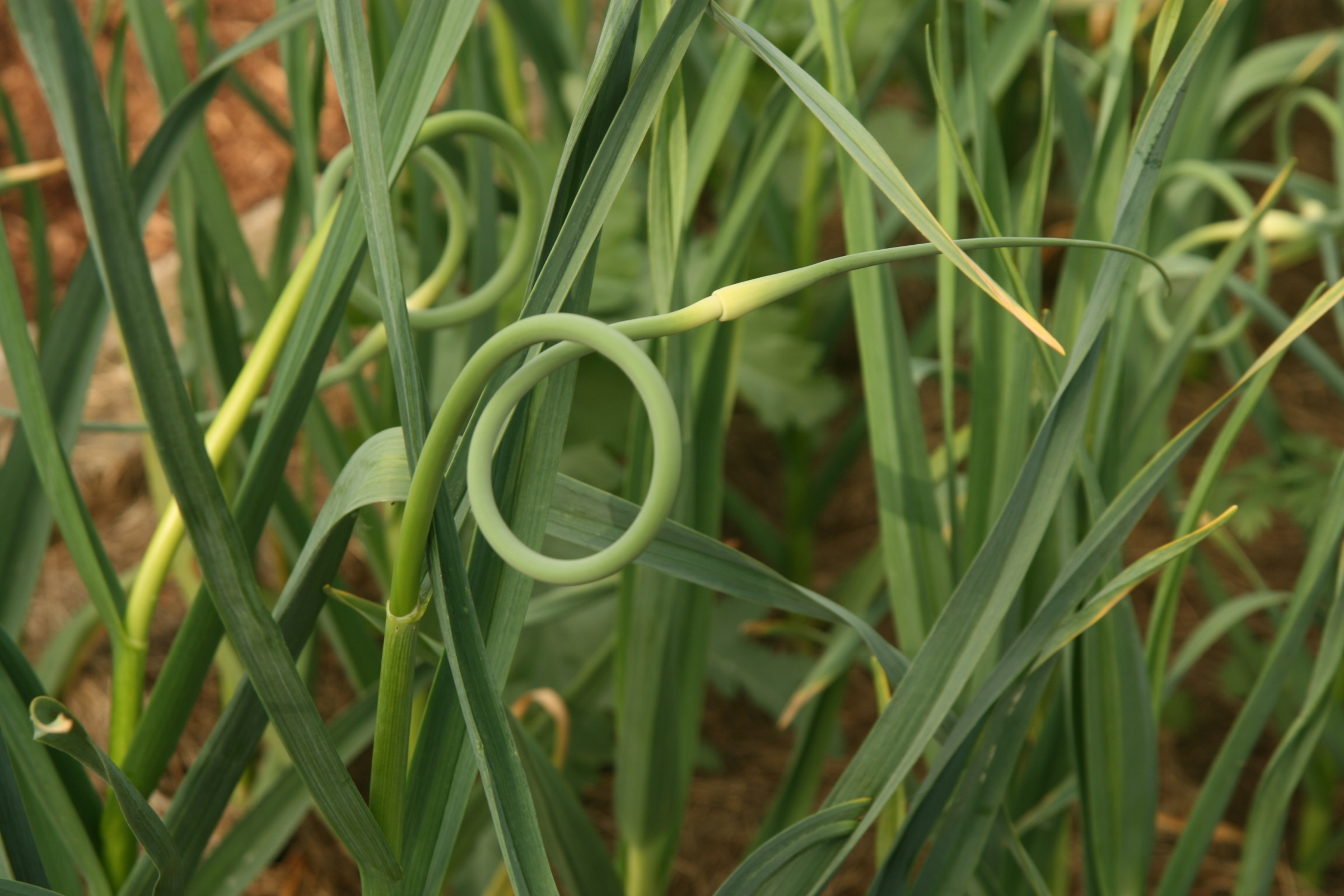





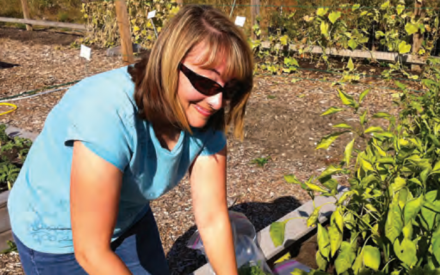 Raised Beds and Containers for Community Gardens
Raised Beds and Containers for Community Gardens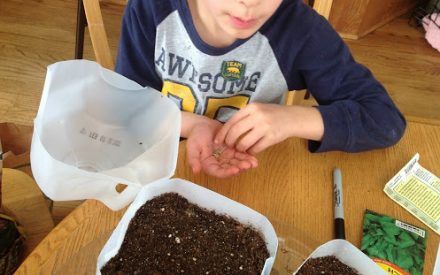 Seed Starting
Seed Starting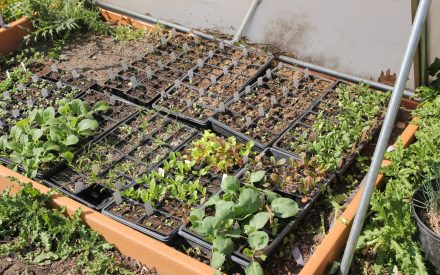 Growing Vegetables at Home: Questions and Answers
Growing Vegetables at Home: Questions and Answers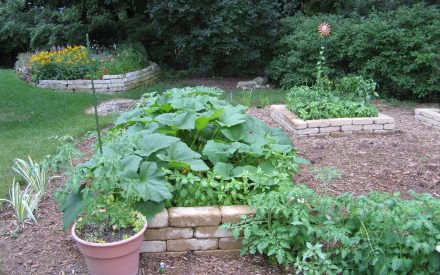 Growing Vegetables in Containers
Growing Vegetables in Containers


